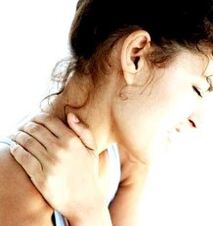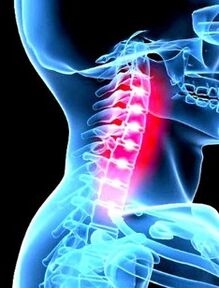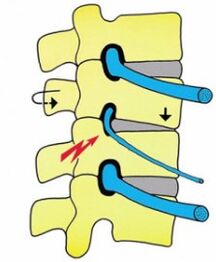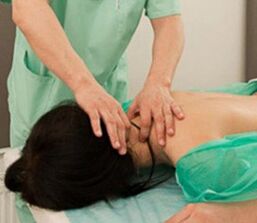Cervical osteochondrosis is a disease that is a dystrophic and degenerative disorder of the cervical discs of the spine. The cervical part is the most mobile, the muscle corset of this department in connection with others is much more glorious. The neck performs the rotation and inclination of the head so that the spine in this area is subject to deformation, destruction, hernia and curvature.
Osteochondrosis has been found to be a disease that "becomes young". This disease is now increasingly found among persons between the ages of 18 to 30, while before that, 40 are considered a norm. The reasons for this can be distinguished by the following:
Osteochondrosis is essentially a consequence of muscle brackets, muscle spasm ultimately downplayed the mobility of the cervical spine, disrupts blood circulation, worsens the blood supply to the bones and muscle tissues, which provokes the development of dystrophic processes in the discs and vertebrai, cutting. As a result, drained nerve roots and loss of sensitivity.
Cervical osteochondrosis has different symptoms. However, in the bigger part, the osteochondrosis that manifests itself affects the circulatory system. There are many blood vessels in the cervical region that intensively nourish the brain. Therefore, the risk of osteochondrosis is associated with poor supply of the organs of the head, especially the brain, the blood. What signs of osteochondrosis of the cervical spine will be expressed by the segment that is defeated. Therefore, the following signs of cervical osteochondrosis are distinguished:
What are the symptoms of cervical osteochondrosis in case Rooser syndrome is characteristic? Rooser syndrome in medicine is called cervical radiculitis, it is found due to nerve pinches in the neck. The pain occurs in the neck, descends into the area of the shoulder blades, can be lower on the shoulder and forearm to the fingers. The characteristic signs of cervical osteochondrosis in this case are the attempt of numbness, burning senses, pastotism, numbness of the hands, forearm or fingers.
The symptoms of osteochondrosis of the cervical region will have different, which the segment falls under damage to the disease, will affect their difference. If the central nerve and its roots are affected, the pastosis will be average, an index, and the thumb. If the roots of the shoulder nerve have been affected, then the pastosis will be a small finger and a ring. Osteochondrosis of the cervical spine, the symptoms will have the following syndrome such as irritation-reflex. The main characteristic will be the presence of acute, intense, burning pain in the cervix and administration or in the neck itself. The pain tends to increase during movement or loads, it is especially acute after a static condition. For example, after sleep, with inaccurate turns of the head, after sleep. The cervical osteochondrosis of the symptoms is similar, as with the development of this syndrome the pain is transmitted to the breast. It is diagnosed in cases where the area of damage is not limited to the neck but goes to the chest segments. Symptoms show a larger spectrum than cervical osteochondrosis, the most basic of them is a violation of the work of the internal organs.
Spinal artery syndrome - exacerbation of cervical osteochondrosis, symptoms are extremely intensive and consist of severe, burning pain. The throbbing pain in the temples, the presence of a strong migraine, which is particularly surprised by the parietal part, the back of the head and the area of the front, are characteristic. The pain is chronic, constant, but sometimes they record cases of paroxysmal pain. The exacerbation of osteochondrosis of the cervical spine expresses symptoms in the form of increasing pain. This happens after being in uncomfortable postures, with sudden movements, serious physical activity. Exacerbation threatens the auditory disorders - a vestibular disorder that experiences tinnitus, as well as a decrease in hearing acuity. Vision problems are not uncommon. Osteochondrosis of the symptoms of cervical spy with cardinal syndrome. Cardinal syndrome is characterized by severe angina. It makes it difficult to identify the primary disease - osteochondrosis. Diagnosis of "osteochondrosis of the cervical region" is often performed in a timely manner as they try to diagnose angina and treat it, this threatens the transition of osteochondrosis to chronic form. 
The phenomenon of angina is provoked by squeezing the spine in the lower segments of the cervical region, which finds a reflex response. Cardinal syndrome may occur in cases where the roots of the chest or diaphragmatic nerve are irritated. Osteochondrosis of the symptoms of the cervical spine with cardinal syndrome can occur in the form of tachycardia, extrasystole. There are frequent cases where osteochondrosis of the cervical region and hypertension also continue. Similarly, the symptoms of cervical osteochondrosis are symptoms, its treatment does not always occur in a timely manner, as doctors initially diagnose cardiovascular disease rather than osteochondrosis.
A certain syndrome is diagnosed by the predominance of certain symptoms, treatment is already performed on the basis of this. Treatment is performed in two ways: either radical, suggesting surgery or a conservative method. In these cases, if conservative treatment does not produce results, an indication of surgery is prescribed. Osteochondrosis of the cervical region is eliminated by the following methods:
Typically, drug treatment is prescribed when symptoms include severe pain. In fact, the pills are not a panacea of the cause of the pain - osteochondrosis itself. The tablets are also prescribed if the cervical osteochondrosis temperature has risen. This symptom indicates the presence of inflammatory processes in the body, inflammation of the tissues and nerves should be eliminated. 
An effective and affordable method of treatment is considered to be a complex of exercise and gymnastic exercises. Exercises are aimed at increasing the flexibility of the cervical spine, increasing the distance between discussions, strengthening the muscle corset that would protect the spine from injury and damage. Also, gymnastics and exercise very effectively establish the functioning of the circulatory system, not only promotes bone tissue, but also allows us to normalize blood flow to the brain. The main thing is to exercise under the supervision of a doctor.
If conservative treatment does not produce results, the surgery is prescribed. It provides the removal of processes, arches and connections, as well as the removal of hernias that have fallen into the spine duct. Following this procedure, cases of general instability of the cervical region are not uncommon. After the patient's surgery, a special support collar is prescribed, which stabilizes the weak neck and temporarily maintains it.
As a rule, if you diagnose the disease in a timely manner, conduct the strict recommendations of the doctor and get involved in complete conservative therapy, then osteochondrosis is significantly adjusted, in many cases a picture of complete recovery is observed.

























